Creative Uses for Used Conveyor Belt Ideas
In today’s eco-conscious world, the importance of recycling and repurposing materials cannot be overstated. As industries seek sustainable solutions, the focus often turns to unexpected resources that offer potential for creative reuse. One such resource is the conveyor belt. Used extensively across various sectors—from mining to retail—conveyor belts are robust and versatile. Once retired from their primary role, these belts present unique opportunities for repurposing. Embracing used conveyor belt ideas not only contributes to environmental sustainability but also unlocks a wealth of innovative applications. By transforming what would otherwise be industrial waste, we can significantly reduce landfill contributions and foster a culture of resourcefulness and innovation.
The Environmental Impact of Used Conveyor Belt Ideas
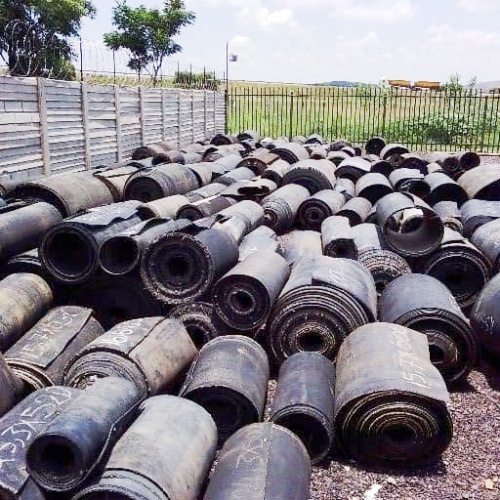
The disposal of used conveyor belts poses significant environmental challenges. These durable belts, made primarily from rubber and metal, are difficult to decompose and can occupy substantial landfill space.
- Landfill Overload: Used conveyor belts contribute to the ever-growing problem of landfill overflow. Their bulky and non-biodegradable nature takes up valuable space that could be used for more decomposable waste.
- Soil Contamination: The materials in conveyor belts can leach toxic chemicals into the soil, affecting the surrounding land’s fertility and potentially entering the groundwater.
- Wildlife Disruption: Large pieces of discarded conveyor belts can become environmental hazards, entangling wildlife or disrupting natural habitats when improperly disposed of in natural settings.
- Resource Wastage: The production of conveyor belts involves significant amounts of natural and synthetic materials. Discarding these belts wastes resources that could be reused or recycled in other forms.
- Carbon Footprint: The production and disposal of conveyor belts contribute to carbon emissions, both from manufacturing processes and the degradation process in landfills, which often involves incineration.
Industries replacing their conveyor systems generate considerable amounts of waste. This waste primarily consists of these old belts, which, due to their size and the materials used, pose a considerable disposal problem. Exploring and implementing used conveyor belt ideas for repurposing can mitigate these environmental issues by reducing the volume of waste and finding value in what was once considered mere scrap.
Innovative Ways to Recycle Used Conveyor Belt Ideas

The potential of used conveyor belts as a resource rather than mere waste is vast and largely untapped. These sturdy materials, primarily composed of rubber and reinforced with metal or fabric, are designed for durability and longevity, making them perfect candidates for repurposing. Here are several innovative ways to recycle used conveyor belt ideas, transforming them from industrial waste into valuable assets:
- Outdoor Furniture: Used conveyor belts can be cleaned, cut, and transformed into weather-resistant surfaces for outdoor benches, tables, or decorative panels. Their durability makes them ideal for outdoor environments.
- Flooring Solutions: In workshops, garages, or gyms, the rubber material of conveyor belts offers excellent shock absorption and durability as flooring. This not only recycles the material but also provides a cost-effective alternative to traditional flooring materials.
- Protective Linings: Conveyor belts can be used to line cargo areas in vehicles, protecting the original material from wear and tear. This is particularly useful in utility vehicles and trucks where heavy or abrasive materials are transported.
- Landscaping and Garden Paths: The rugged material of used conveyor belts is excellent for creating durable, weather-resistant pathways in gardens. They can also be used as protective barriers beneath the soil to prevent weeds in garden beds.
- Art Projects: The unique texture and material of conveyor belts can be utilized in large-scale art installations or smaller crafts. Artists and DIY enthusiasts can explore used conveyor belt ideas to create striking pieces that highlight the industrial aesthetic.
- Equestrian Applications: Used conveyor belts can be repurposed into durable mats for stable floors, providing a comfortable and easy-to-clean surface for horses. They can also be used in arenas as part of the footing material.
These recycling initiatives not only extend the life cycle of used conveyor belts but also help reduce the environmental impact of disposing of such large quantities of durable material. By viewing used conveyor belt ideas as resources, we can significantly decrease industrial waste and inspire creativity in uses far beyond their original purpose.
Optimize efficiency with our top-quality conveyor belts.
Used Conveyor Belt Ideas for the Home and Garden
The versatility of used conveyor belts makes them an excellent choice for both functional and decorative uses around the home and garden. Here are some creative ways to implement used conveyor belt ideas in these settings:
DIY Home Decor:
- Rugged Door Mats: Cut used conveyor belts into smaller, manageable pieces to create durable door mats that withstand all weather conditions.
- Wall Hangings: Use sections of conveyor belts as a canvas for painting or attach various decorative items to create a unique, industrial-style wall art.
- Shelf Liners: Conveyor belts can be cut and fitted to line shelves, providing a non-slip surface that’s perfect for tools in a garage or pots in a kitchen.
- Furniture Upholstery: Durable and unique, conveyor belts can be used to upholster stool tops or outdoor bench seats, adding a rustic or industrial flair to home furnishings.
- Frame Backdrops: Use strips of conveyor belts as textural backdrops for framed photographs or artwork, adding depth and interest to the display.
Gardening Uses:
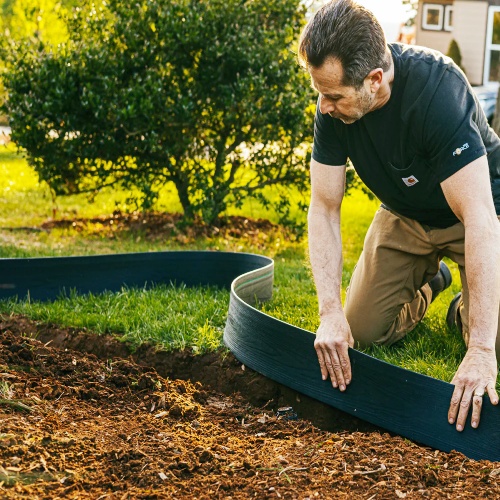
- Pathways: Lay strips of used conveyor belts on the ground to form stable, mud-free pathways in the garden. These paths are especially useful in wet climates or heavily trafficked areas of the garden.
- Planters: Conveyor belts can be shaped into cylindrical or rectangular planters that provide a sturdy container for outdoor plants. Their durability ensures they can hold soil and plants without deteriorating.
- Protective Barriers: Cut the belts to fit around the base of trees or along garden beds to serve as barriers that keep pests out and reduce weed growth.
- Mulch Mats: Place conveyor belt pieces around plants as mulch mats to retain moisture in the soil and suppress weeds.
- Hanging Gardens: Use vertically suspended conveyor belts to create hanging gardens, ideal for small spaces or to add vertical interest to your garden area.
These used conveyor belt ideas not only recycle an otherwise wasted resource but also add a distinctive and practical element to home and garden projects. By reimagining how we use these materials, we can significantly enhance the functionality and aesthetics of our living spaces.
Used Conveyor Belt Ideas in the Community
Utilizing used conveyor belt ideas in community settings can lead to innovative and sustainable solutions that benefit public spaces and animal shelters.
Playgrounds and Parks:
- Ground Cover: Used conveyor belts can be laid as ground cover in playgrounds, providing a durable, safe, and shock-absorbent surface that reduces the risk of injuries.
- Climbing Structures: The flexibility and strength of conveyor belts make them ideal for creating climbing structures for children. They can be used to craft ropes or wrapped around existing frames to enhance safety and durability.
- Walking Trails: In parks, used conveyor belts can be used to pave walking trails, making them accessible in all weather conditions and reducing maintenance needs.
- Border Edging: Conveyor belts can serve as strong and flexible border edging for sandboxes, flower beds, or any area in a park that needs a defined boundary that withstands weather and heavy use.
- Outdoor Gym Equipment: Tough and weather-resistant, conveyor belts are perfect for constructing outdoor gym equipment such as pull-up bars or balance beams, contributing to the community’s health and well-being.
Animal Shelters:
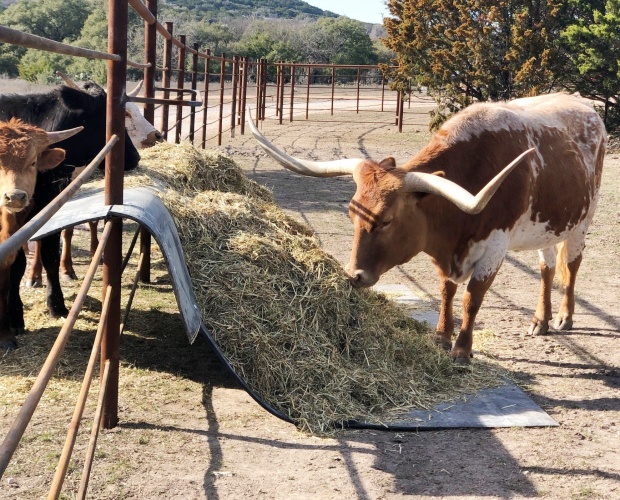
- Bedding for Larger Animals: The durable nature of conveyor belts makes them suitable for bedding in stalls for horses or cows in animal shelters, providing a comfortable, easy-to-clean surface.
- Cage Lining: Cutting conveyor belts to size and fitting them inside cages can protect the base from wear and make cleaning easier, enhancing the comfort of smaller animals.
- Play Areas: For larger animal compounds, used conveyor belts can be turned into play ramps or scratching posts for animals like goats or cats.
- Feeding Stations: Conveyor belts can be utilized to create robust feeding stations that are easy to clean and maintain, ideal for both small and large animal shelters.
- Protective Wall Coverings: Using conveyor belts to cover walls in animal shelters can help insulate the space and protect the walls from damage, making the environment safer for all types of animals.
These applications of used conveyor belt ideas not only repurpose an industrial product but also enhance the functionality and safety of community spaces and animal shelters. By integrating these sustainable practices, communities can improve their local environments while promoting recycling and creative reuse.
Used Conveyor Belt Ideas on the Farm
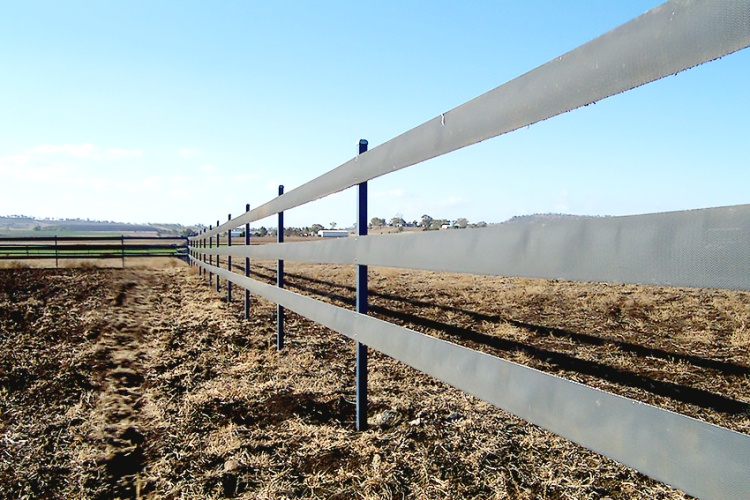
Farms can greatly benefit from implementing used conveyor belt ideas, utilizing these sturdy materials in various agricultural applications. Here’s how conveyor belts can be repurposed effectively on the farm:
- Lining Troughs: Used conveyor belts can be cut to size and used to line feed troughs for livestock. This not only prolongs the life of the wooden troughs but also makes cleaning easier and more efficient.
- Creating Shelters: By attaching conveyor belts to frames, farmers can create durable, weather-resistant shelters for animals or storage. These shelters provide protection from the elements and can be easily relocated as needed.
- Flooring for Stables and Barns: The strength and durability of conveyor belts make them ideal for flooring in stables and barns. They provide a non-slip surface that is easy to clean and maintain, improving the safety and hygiene of the spaces where animals are kept.
- Protective Wrapping for Trees and Plants: During harsh weather, young trees and plants can be wrapped with strips of conveyor belt to protect them from wind, frost, and pests. This method is a cost-effective alternative to more expensive commercial products.
- Irrigation Channels: Used conveyor belts can be shaped into channels to direct water flow in irrigation systems. This can help in efficiently managing water use on the farm, directing it to where it is most needed without significant evaporation losses.
- Weed Suppression: Conveyor belts can be used to cover areas between rows of crops to suppress weeds. This reduces the need for chemical herbicides and frequent tilling, promoting a more organic farming approach.
These used conveyor belt ideas provide practical, cost-effective solutions for various challenges on the farm. By repurposing these robust materials, farmers can enhance operational efficiency, improve animal welfare, and increase sustainability in their farming practices.

Sourcing Used Conveyor Belt Ideas
Finding used conveyor belts for your projects can be straightforward if you know where to look and how to approach potential suppliers. Here are guidelines and tips for sourcing used conveyor belts from local businesses or online platforms, as well as advice on how to approach local industries for potential donations or low-cost purchases.
Guidelines for Sourcing Online and Locally:
- Online Platforms: Websites like Craigslist, eBay, or Freecycle can be excellent resources for finding used conveyor belts. Search for listings under industrial equipment or surplus materials. Be specific in your search terms to filter through the listings more effectively.
- Local Industrial Suppliers: Many industrial suppliers or dealers in mining, manufacturing, and agricultural equipment may have used conveyor belts available. Contacting them directly can lead to finding what you need at a competitive price.
- Recycling Centers: Some recycling centers handle large-scale industrial waste and may have conveyor belts available. These centers often sell reclaimed materials at lower costs.
- Construction Companies: Companies that specialize in demolition or construction may come across conveyor belts in their operations and might be willing to sell or donate them.
- Manufacturing Plants: Reach out to local manufacturing plants, particularly those that are involved in packaging, mining, or any sector where conveyor systems are prevalent. They often replace their conveyor belts and might have old ones lying around.
Approaching Local Industries for Donations or Purchases:
- Prepare a Proposal: When approaching a company, it helps to have a clear proposal that outlines how you intend to use their used conveyor belts. This shows your seriousness and professionalism.
- Highlight the Environmental Benefit: Emphasize the environmental benefits of donating or selling used conveyor belts for repurposing. Companies are often motivated by the opportunity to enhance their corporate social responsibility.
- Offer to Handle Logistics: Propose to manage the removal and transportation of the conveyor belts, easing the burden on the donating or selling company.
- Negotiate Pricing: If not free, try to negotiate a fair price. Be prepared to explain why your offer is reasonable, possibly by comparing costs of new materials.
- Leverage Local Networks: Utilize local business networks or chambers of commerce to get introductions to the right people within large industries who may help you source used conveyor belts.
By following these guidelines and tips, you can effectively locate and acquire used conveyor belts, turning them into valuable resources for your used conveyor belt ideas. This approach not only helps in reducing industrial waste but also supports sustainability and creativity in community and personal projects.
Preparing Used Conveyor Belt Ideas for Repurposing
Before implementing used conveyor belt ideas, it is crucial to properly prepare the belts to ensure they are safe and suitable for new purposes. This preparation involves cleaning, performing safety checks, and applying cutting and shaping techniques to fit various needs. Here’s a step-by-step guide to get your used conveyor belts ready for repurposing:
Basic Cleaning and Safety Checks:
- Cleaning: Start by removing any dirt, debris, or residues from the conveyor belts. Use a high-pressure water spray or scrub the belts with a solution of mild detergent and water to clean the surface thoroughly. For tougher grime, a degreaser might be necessary.
- Safety Inspection: Examine the belts for any sharp edges, significant wear, or damage. It’s essential to repair or smooth out any harmful parts to prevent injuries. Look for any metallic elements that might need to be removed or treated to prevent rust.
- Dry and Sanitize: After cleaning, allow the belts to dry completely. If the belts will be used indoors or in sensitive environments (like gardens or play areas), consider sanitizing them with a suitable disinfectant to eliminate any lingering bacteria or molds.
Cutting and Shaping Techniques:
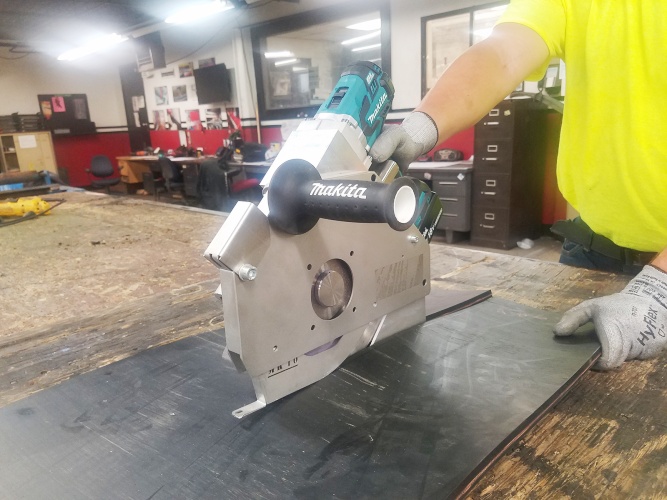
- Straight Cuts for Mats: For creating floor mats or liners, measure and mark your desired dimensions on the belt, then use a utility knife or a heavy-duty cutter to make straight cuts. A straightedge or metal ruler can help guide your cuts to ensure they are clean and even.
- Curved Cuts for Planters: When shaping conveyor belts into cylindrical planters, make curved cuts to allow the belt to conform to circular molds or frames. A jigsaw or band saw can be used for these types of cuts, giving you the flexibility to create custom shapes.
- Punching Holes for Drainage or Decorative Purposes: Use a leather punch or a drill to make holes in the conveyor belt. This is particularly useful for applications like garden planters where drainage is necessary or for decorative purposes in DIY home decor.
- Scoring and Folding: For creating sharp bends or folds in a conveyor belt, such as making corners in a rectangular planter, score the inner side of the belt where the fold is needed. A strong utility knife or a rotary tool can be used to score the belt deeply enough to facilitate a clean fold without cutting through entirely.
- Sanding Edges for Safety and Aesthetics: After cutting, use a sanding block or an electric sander to smooth any rough edges or corners. This not only enhances the safety of the finished product but also improves its aesthetic appearance.
By following these detailed steps, you can ensure that your used conveyor belt ideas are executed safely and effectively. Proper preparation not only extends the life of your projects but also maximizes the functionality and appeal of the repurposed materials.
Contact us for custom conveyor belt solutions.
Success Stories: Celebrating Used Conveyor Belt Ideas
The innovative repurposing of used conveyor belts has led to numerous success stories around the world. From small-scale DIY projects to large community initiatives, these used conveyor belt ideas have not only promoted sustainability but also sparked creativity in various fields. Here are a few inspiring case studies and anecdotes that highlight the successful application of repurposed conveyor belts:
Community Playground Renovation:
In a small town in Minnesota, the community came together to revamp their local playground using used conveyor belts. These belts were transformed into safe, durable, and colorful ground covers and climbing structures for the playground. The project not only saved the community considerable costs compared to commercial materials but also provided a longer-lasting and safer play area for children.
Agricultural Innovation on a Family Farm:
A farmer in Oregon used conveyor belts to line the floors of his barns and create low-cost, durable troughs for his livestock. The conveyor belts proved to be exceptionally resilient against the wear and tear typical in agricultural settings, significantly reducing maintenance costs and improving the overall efficiency of farm operations.
Art Installation in Urban Spaces:
An artist in Berlin utilized used conveyor belts to create a dynamic, interactive art installation in a popular city park. The installation, consisting of sculptural elements made from the belts, encouraged public interaction and conversation about recycling and the repurposing of industrial materials.
Garden Enhancement by a Local Gardening Club:
A gardening club in California employed used conveyor belts as innovative gardening solutions. They used the belts to create garden pathways, mulch mats, and even decorative borders that added an industrial chic element to their community garden plots. This approach not only reused a significant amount of material but also inspired other clubs in the region to consider similar sustainable gardening practices.
Animal Shelter Improvements:
An animal shelter in Texas found a novel use for conveyor belts by converting them into durable bedding for the kennels of larger animals and lining for the floors. These improvements made the shelters easier to clean and more comfortable for the animals, showcasing a practical and compassionate use of recycled materials.
Each of these stories demonstrates the versatility and potential of used conveyor belt ideas in contributing to environmental sustainability and community enhancement. By sharing these success stories, we aim to inspire others to see the value in repurposing materials and to think creatively about how industrial waste can be transformed into valuable resources.
FAQs About Used Conveyor Belt Ideas
Conveyor belts are incredibly versatile and are used in various industries to facilitate the movement of materials from one point to another. They are commonly found in airports for baggage handling, in supermarkets for checkout lanes, in manufacturing plants for assembling products, in mining operations for transporting extracted materials, and in agricultural settings for moving grain or other bulk products. Additionally, conveyor belts are essential in packaging and distribution centers, where they help in sorting, processing, and shipping goods efficiently. Their ability to handle a wide range of materials, from small components to large boxes, makes them indispensable in many sectors.
The useful life of a conveyor belt depends on several factors, including the type of material it is made from, the conditions under which it operates, and how well it is maintained. Generally, a well-maintained conveyor belt can last anywhere from three to ten years. However, belts used in harsher environments—such as those exposed to extreme temperatures, abrasive materials, or heavy loads—may have a shorter lifespan. Regular inspections and maintenance, such as adjusting tension, cleaning, and checking for wear and tear, are crucial in extending the life of a conveyor belt. Replacing worn parts and ensuring that the belt is correctly aligned and tensioned can also significantly affect its durability and functionality.
Conveyor belts have a wide array of applications across many industries. They are used in food production for moving ingredients through processing and packaging lines, in automotive manufacturing as part of assembly lines, and in pharmaceuticals for transporting products through controlled environments. Conveyor belts also play a critical role in warehouse automation, helping to transport goods across different stages of processing and storage. Other notable applications include baggage handling systems at airports, material handling in construction sites, and resource transportation in mining. The versatility of conveyor belts makes them suitable for automating processes and improving efficiency in virtually any production, handling, or distribution environment.
Alternatives to conveyor belts vary depending on the specific needs of the operation. For settings where flexibility in route and movement is necessary, automated guided vehicles (AGVs) or mobile robots can be used. These vehicles provide the advantage of moving goods across multiple areas without the need for fixed routes, unlike conveyor belts. For operations requiring the lifting and positioning of heavy items, cranes or hoists might be more suitable. Pneumatic and vacuum conveyors are options for transporting powders, grains, or other small particles. Additionally, for simple or small-scale operations, manual carts or trolleys can be an economical and straightforward alternative. Each alternative comes with its own set of advantages, and the choice will depend on the specific requirements of the application, including speed, volume, and nature of the materials to be transported.
Repurpose for New Uses:
Ground Covering: Use it as a durable ground cover in playgrounds, gardens, or equestrian areas.
Agricultural Applications: Line barn floors, create animal troughs, or use as protection for equipment.
Art Projects: Transform into art installations or sculptures.
Pathways and Mulch Mats: Lay it down for garden pathways or as mulch mats.
Bedding and Flooring: Convert into durable bedding or flooring for animal shelters.
Recycle:
Contact local recycling facilities that handle industrial materials to recycle the rubber and metal components.
Sell or Donate:
Sell it to businesses or individuals who can repurpose it, or donate it to community projects or schools.
DIY Projects:
Use for personal projects like making heavy-duty mats, barriers, or protective surfaces.
Landfill Liners:
Use in landfill sites as a liner to prevent contamination.
The cost of a conveyor belt can vary significantly depending on various factors:
Material and Type:
PVC Belts: Generally more affordable, used in lightweight and general-purpose applications.
Rubber Belts: Mid-range price, suitable for heavy-duty applications.
Specialty Belts: Higher cost for belts with specific properties like fire resistance, food-grade quality, or antistatic features.
Length and Width:
Longer and wider belts will naturally cost more. Prices can range from $10-$30 per foot for standard belts.
Ply and Thickness:
The number of plies and the thickness of the belt also affect the price. More plies and greater thickness typically mean higher prices.
Custom Features:
Customizations such as cleats, sidewalls, and special coatings will increase the cost.
Approximate Price Ranges:
Standard PVC Conveyor Belts: $10-$50 per foot.
Heavy-Duty Rubber Conveyor Belts: $30-$100 per foot.
Specialty Conveyor Belts: $50-$200+ per foot depending on the specific requirements and features.
For exact pricing, it’s best to contact suppliers directly and provide details about your specific needs.
Jordan Smith, a seasoned professional with over 20 years of experience in the conveyor system industry. Jordan’s expertise lies in providing comprehensive solutions for conveyor rollers, belts, and accessories, catering to a wide range of industrial needs. From initial design and configuration to installation and meticulous troubleshooting, Jordan is adept at handling all aspects of conveyor system management. Whether you’re looking to upgrade your production line with efficient conveyor belts, require custom conveyor rollers for specific operations, or need expert advice on selecting the right conveyor accessories for your facility, Jordan is your reliable consultant. For any inquiries or assistance with conveyor system optimization, Jordan is available to share his wealth of knowledge and experience. Feel free to reach out at any time for professional guidance on all matters related to conveyor rollers, belts, and accessories.



